Page 113 of 192
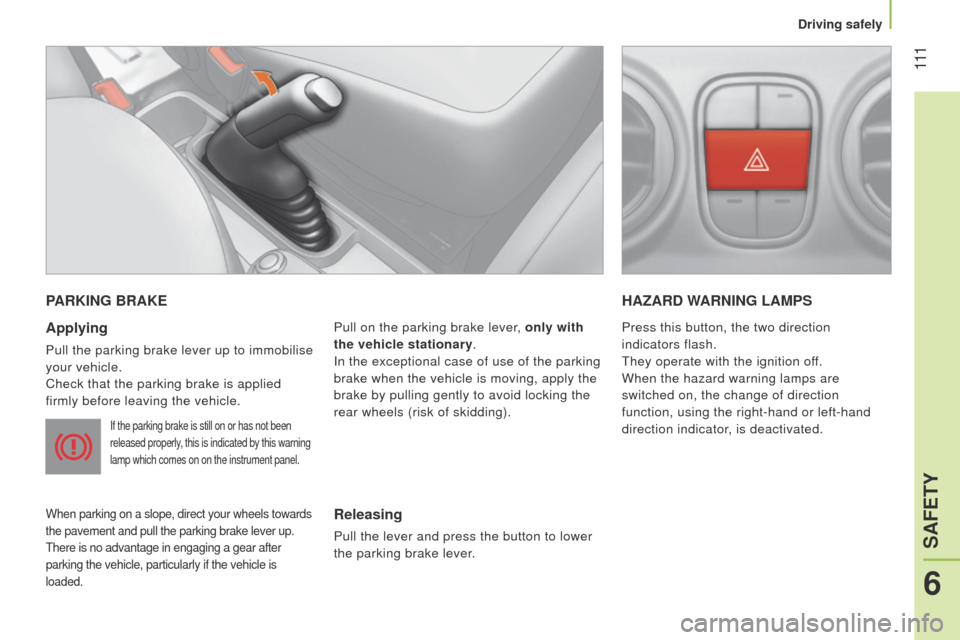
111
Bipper_en_Chap06_securite_ed02-2014
PARKING BRAKE
Applying
Pull the parking brake lever up to immobilise
your vehicle.
Check that the parking brake is applied
firmly before leaving the vehicle.
If the parking brake is still on or has not been
released properly, this is indicated by this warning
lamp which comes on on the instrument panel.
When parking on a slope, direct your wheels towards
the pavement and pull the parking brake lever up.
t
here is no advantage in engaging a gear after
parking the vehicle, particularly if the vehicle is
loaded.
Pull on the parking brake lever, only with
the vehicle stationary.
In the exceptional case of use of the parking
brake when the vehicle is moving, apply the
brake by pulling gently to avoid locking the
rear wheels (risk of skidding).
HAZARD WARNING LAMPS
Releasing
Pull the lever and press the button to lower
the parking brake lever. Press this button, the two direction
indicators flash.
t
hey operate with the ignition off.
When the hazard warning lamps are
switched on, the change of direction
function, using the right-hand or left-hand
direction indicator, is deactivated.
6
SAFETY
Driving safely
Page 114 of 192
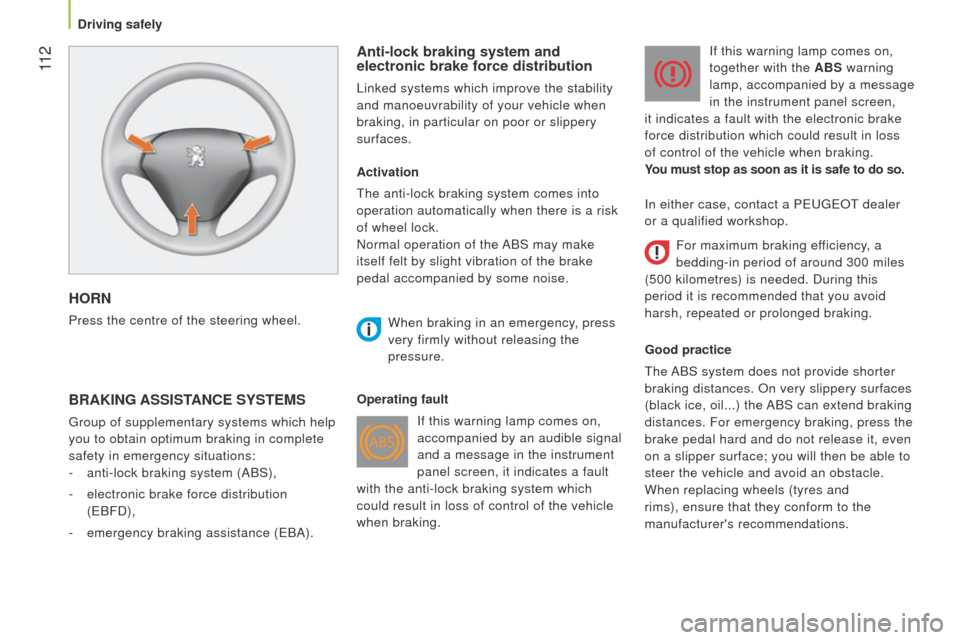
11 2
Bipper_en_Chap06_securite_ed02-2014
HORN
Press the centre of the steering wheel.
Anti-lock braking system and
electronic brake force distribution
linked systems which improve the stability
and manoeuvrability of your vehicle when
braking, in particular on poor or slippery
surfaces.
BRAKING ASSISTANCE SYSTEMS
group of supplementary systems which help
you to obtain optimum braking in complete
safety in emergency situations:
-
anti-lock braking system (ABS),
-
electronic brake force distribution
(
e BFD),
-
emergency braking assistance (
e BA).Activation
t
he anti-lock braking system comes into
operation automatically when there is a risk
of wheel lock.
Normal operation of the ABS may make
itself felt by slight vibration of the brake
pedal accompanied by some noise.
When braking in an emergency
, press
very firmly without releasing the
pressure.
Operating fault If this warning lamp comes on,
accompanied by an audible signal
and a message in the instrument
panel screen, it indicates a fault
with the anti-lock braking system which
could result in loss of control of the vehicle
when braking. If this warning lamp comes on,
together with the ABS warning
lamp, accompanied by a message
in the instrument panel screen,
it indicates a fault with the electronic brake
force distribution which could result in loss
of control of the vehicle when braking.
You must stop as soon as it is safe to do so.
Good practice
t
he ABS system does not provide shorter
braking distances. On very slippery surfaces
(black ice, oil...) the ABS can extend braking
distances. For emergency braking, press the
brake pedal hard and do not release it, even
on a slipper surface; you will then be able to
steer the vehicle and avoid an obstacle.
When replacing wheels (tyres and
rims), ensure that they conform to the
manufacturer's recommendations. In either case, contact a P euge O t
dealer
or a qualified workshop.
For maximum braking efficiency, a
bedding-in period of around 300 miles
(500 kilometres) is needed. During this
period it is recommended that you avoid
harsh, repeated or prolonged braking.
Driving safely
Page 115 of 192
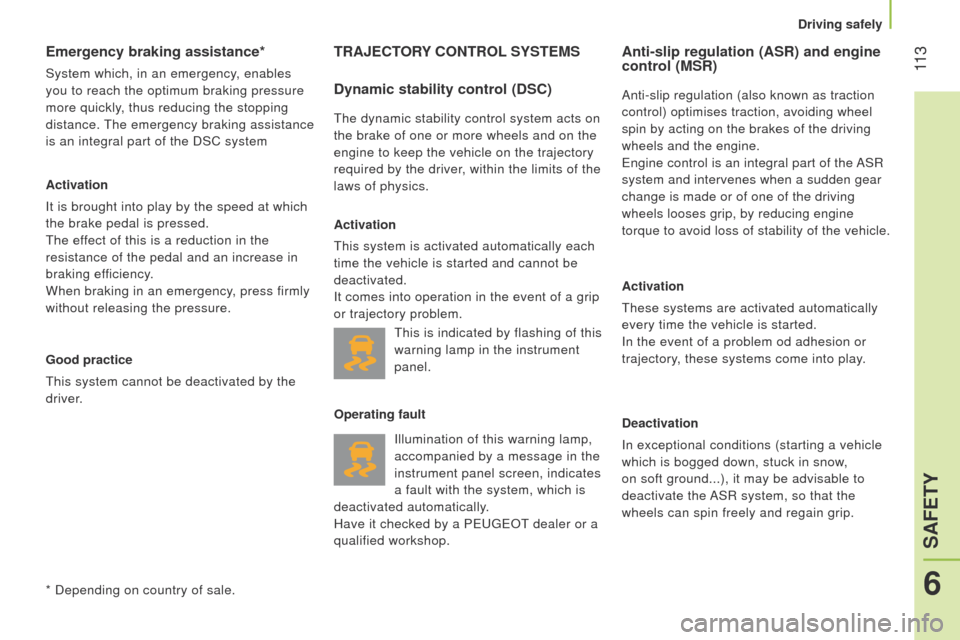
11 3
Bipper_en_Chap06_securite_ed02-2014
Emergency braking assistance*
System which, in an emergency, enables
you to reach the optimum braking pressure
more quickly, thus reducing the stopping
distance.
t
he emergency braking assistance
is an integral part of the DSC system
Activation
It is brought into play by the speed at which
the brake pedal is pressed.
t
he effect of this is a reduction in the
resistance of the pedal and an increase in
braking efficiency.
When braking in an emergency, press firmly
without releasing the pressure.
Good practice
t
his system cannot be deactivated by the
driver.
* Depending on country of sale.
TRAJECTORY CONTROL SYSTEMS
Dynamic stability control
(DSC)
the dynamic stability control system acts on
the brake of one or more wheels and on the
engine to keep the vehicle on the trajectory
required by the driver, within the limits of the
laws of physics.
Activation
t
his system is activated automatically each
time the vehicle is started and cannot be
deactivated.
It comes into operation in the event of a grip
or trajectory problem.
Illumination of this warning lamp,
accompanied by a message in the
instrument panel screen, indicates
a fault with the system, which is
deactivated automatically.
Have it checked by a P
euge O t
dealer or a
qualified workshop.
Anti-slip regulation (ASR) and engine
control (MSR)
Anti-slip regulation (also known as traction
control) optimises traction, avoiding wheel
spin by acting on the brakes of the driving
wheels and the engine.
e
ngine control is an integral part of the ASR
system and intervenes when a sudden gear
change is made or of one of the driving
wheels looses grip, by reducing engine
torque to avoid loss of stability of the vehicle.
Activation
t
hese systems are activated automatically
every time the vehicle is started.
In the event of a problem od adhesion or
trajectory, these systems come into play.
Deactivation
In exceptional conditions (starting a vehicle
which is bogged down, stuck in snow,
on soft ground...), it may be advisable to
deactivate the ASR system, so that the
wheels can spin freely and regain grip.
t
his is indicated by flashing of this
warning lamp in the instrument
panel.
Operating fault
6
SAFETY
Driving safely
Page 116 of 192
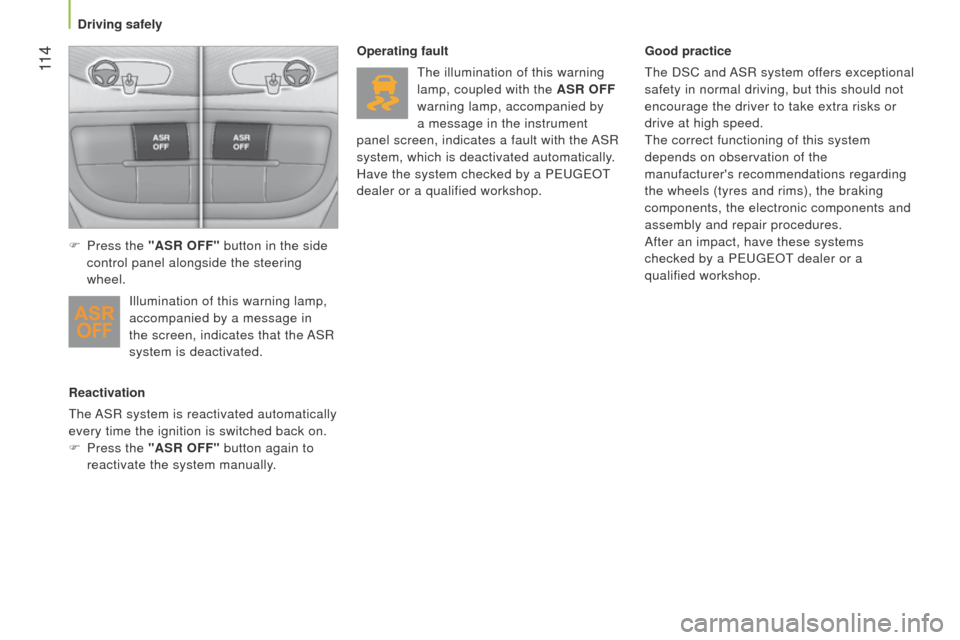
11 4
Bipper_en_Chap06_securite_ed02-2014
Reactivation
t
he ASR system is reactivated automatically
every time the ignition is switched back on.
F
Press the
"ASR OFF" button again to
reactivate the system manually. Operating fault
t
he illumination of this warning
lamp, coupled with the ASR OFF
warning lamp, accompanied by
a message in the instrument
panel screen, indicates a fault with the ASR
system, which is deactivated automatically.
Have the system checked by a P euge O t
dealer or a qualified workshop. Good practice
t
he DSC and ASR system offers exceptional
safety in normal driving, but this should not
encourage the driver to take extra risks or
drive at high speed.
t
he correct functioning of this system
depends on observation of the
manufacturer's recommendations regarding
the wheels (tyres and rims), the braking
components, the electronic components and
assembly and repair procedures.
After an impact, have these systems
checked by a P euge O t
dealer or a
qualified workshop.
F
Press the
"ASR OFF" button in the side
control panel alongside the steering
wheel.
Illumination of this warning lamp,
accompanied by a message in
the screen, indicates that the ASR
system is deactivated.
Driving safely
Page 117 of 192
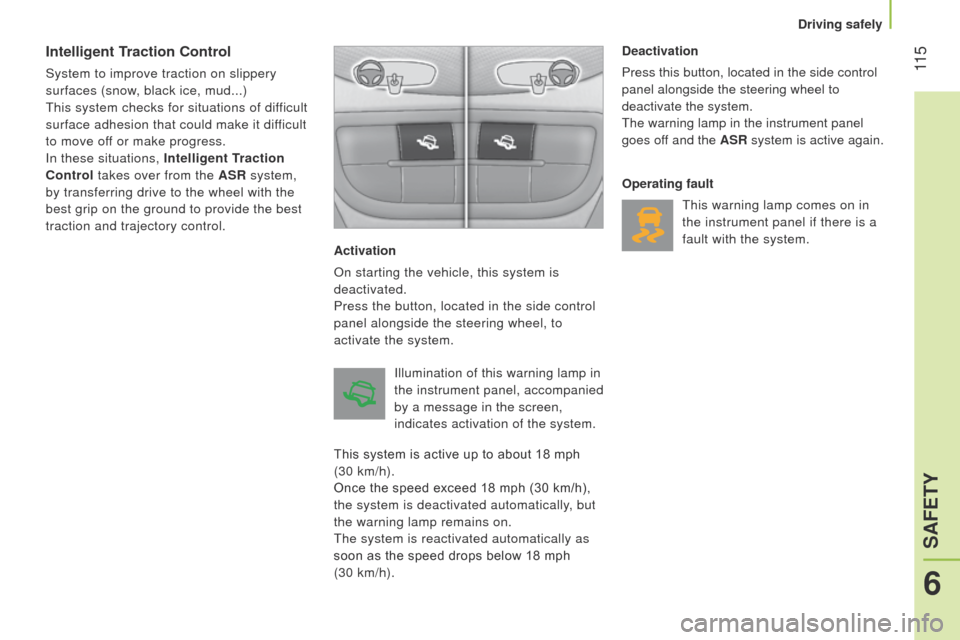
11 5
Bipper_en_Chap06_securite_ed02-2014
Intelligent Traction Control
System to improve traction on slippery
surfaces (snow, black ice, mud...)
t
his system checks for situations of difficult
surface adhesion that could make it difficult
to move off or make progress.
In these situations, Intelligent Traction
Control takes over from the ASR system,
by transferring drive to the wheel with the
best grip on the ground to provide the best
traction and trajectory control.
Activation
On starting the vehicle, this system is
deactivated.
Press the button, located in the side control
panel alongside the steering wheel, to
activate the system.Deactivation
Press this button, located in the side control
panel alongside the steering wheel to
deactivate the system.
t
he warning lamp in the instrument panel
goes off and the ASR system is active again.
Operating fault
t
his warning lamp comes on in
the instrument panel if there is a
fault with the system.
Illumination of this warning lamp in
the instrument panel, accompanied
by a message in the screen,
indicates activation of the system.
This system is active up to about 18 mph
(30 km/h).
Once the speed exceed 18 mph (30 km/h),
the system is deactivated automatically, but
the warning lamp remains on.
t
he system is reactivated automatically as
soon as the speed drops below 18 mph
(30 km/h).
6
SAFETY
Driving safely
Page 118 of 192

11 6
Bipper_en_Chap06_securite_ed02-2014
TYRE UNDER-INFLATION DETECTION
System which automatically checks the
pressure of the tyres while driving.
t
he system monitors the pressures on the
four tyres, once the vehicle is moving.
It compares the information given by the
four wheel speed sensors with reference
values, which must be reinitialised every
time the tyre pressures are adjusted or a
wheel changed.
t
he system triggers an alert as soon as it
detects a drop in the inflation pressure of
one or more tyres.
t
he under-inflation detection system
does not replace the vigilance or the
responsibility of the driver.
t
his system does not avoid the need to
check the tyre pressures (including the
spare wheel) every month as well as before
a long journey.
Driving with under-inflated tyres impairs
road holding, extends braking distances and
causes premature tyre wear, particularly
under arduous condition (high loading, high
speed, long journey).
Driving with under-inflated tyres increases
fuel consumption.
t
he inflation pressures defined for
your vehicle can be found on the tyre
pressure label.
See the "Identification markings" section.
tyre pressures should be checked when the
tyres are "cold" (vehicle stopped for 1 hour
or after a journey of less than 6 miles
(10 km) at moderate speeds).
Otherwise (when hot), add 0.3 bar to the
pressures shown on the label.
Under-inflation alert
This is given by fixed
illumination of this warning lamp,
accompanied the display of a
message,depending on equipment.
F
Reduce speed immediately
, avoid
excessive steering movements and
sudden braking
F
Stop the vehicle as soon as it is safe to
do so.
t
he loss of pressure detected does
not always cause visible bulging of the
tyre. Do not satisfy yourself with just a visual
check.
F
In the event of a puncture, use the
temporary puncture repair kit or the spare
wheel (depending on equipment),
or
F
if you have a compressor
, such as the
one in the temporary puncture repair kit,
check the pressures of the four tyres
when cold,
or
F
if it is not possible to make this check
immediately, drive carefully at reduced
speed.
t
he alert is maintained until the system
is reinitialised.
Driving safely
Page 119 of 192
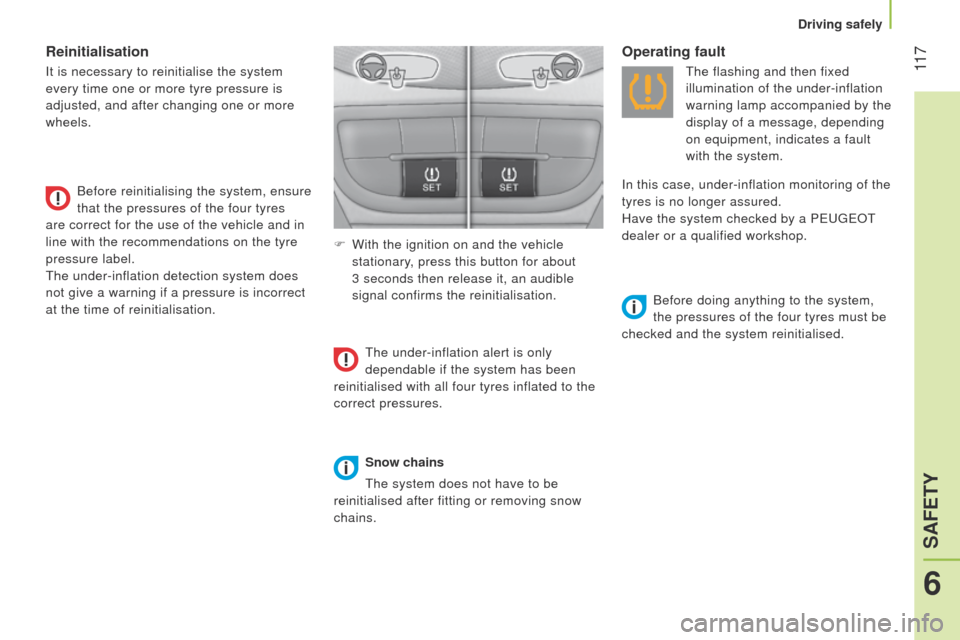
11 7
Bipper_en_Chap06_securite_ed02-2014
Reinitialisation
It is necessary to reinitialise the system
every time one or more tyre pressure is
adjusted, and after changing one or more
wheels.Before reinitialising the system, ensure
that the pressures of the four tyres
are correct for the use of the vehicle and in
line with the recommendations on the tyre
pressure label.
t
he under-inflation detection system does
not give a warning if a pressure is incorrect
at the time of reinitialisation. F
With the ignition on and the vehicle
stationary, press this button for about
3 seconds then release it, an audible
signal confirms the reinitialisation.
t
he under-inflation alert is only
dependable if the system has been
reinitialised with all four tyres inflated to the
correct pressures.
Snow chains
t
he system does not have to be
reinitialised after fitting or removing snow
chains.t he flashing and then fixed
illumination of the under-inflation
warning lamp accompanied by the
display of a message, depending
on equipment, indicates a fault
with the system.
Before doing anything to the system,
the pressures of the four tyres must be
checked and the system reinitialised.
Operating fault
In this case, under-inflation monitoring of the
tyres is no longer assured.
Have the system checked by a P
euge O t
dealer or a qualified workshop.
6
SAFETY
Driving safely
Page 120 of 192

11 8
Bipper_en_Chap06_securite_ed02-2014
FRONT SEAT BELTS
the front seats are fitted with pre-tensioners
and force limiters.
Fastening
Pull the strap, then insert the tongue into the
buckle.
Check that the seat belt is fastened correctly
by pulling the strap.
t
he lap belt must be positioned as low as
possible on the pelvis.
t
he chest belt must
pass over the hollow of the shoulder.
Inertia reel seat belts
these are fitted with a device which locks
automatically in the event of a collision or
emergency braking.
Safety in the event of a front impact has
been improved by the introduction of
pretensioning and force limiting seat belts.
Depending on the seriousness of the
impact, the pretensioning system instantly
tightens the seat belt against the body of the
occupant.
t
he pretensioning seat belts are active when
the ignition is on.
t
he force limiter reduces the pressure of the
seat belt against the body of the occupant in
the event of an accident.
Driver's seat belt not fastened warning
lamp
When the vehicle is started, this
warning lamp comes on if the
driver has not fastened their seat
belt.
REAR SEAT BELTS (COMBI)
the 3-seat bench is fitted with three-point
inertia reel seat belts with force limiter .
t
he centre seat has a seat belt guide and
inertia reel, integrated with the seat back.
When a seat belt is not in use, you can
store its buckle in the housing provided
in the bench seat cushion.
If the driver's seat belt is unfastened,
the S
t
ARt mode of Stop & Start will
not be invoked.
t
he engine can only be
restarted using the ignition key.
Seat belts
 1
1 2
2 3
3 4
4 5
5 6
6 7
7 8
8 9
9 10
10 11
11 12
12 13
13 14
14 15
15 16
16 17
17 18
18 19
19 20
20 21
21 22
22 23
23 24
24 25
25 26
26 27
27 28
28 29
29 30
30 31
31 32
32 33
33 34
34 35
35 36
36 37
37 38
38 39
39 40
40 41
41 42
42 43
43 44
44 45
45 46
46 47
47 48
48 49
49 50
50 51
51 52
52 53
53 54
54 55
55 56
56 57
57 58
58 59
59 60
60 61
61 62
62 63
63 64
64 65
65 66
66 67
67 68
68 69
69 70
70 71
71 72
72 73
73 74
74 75
75 76
76 77
77 78
78 79
79 80
80 81
81 82
82 83
83 84
84 85
85 86
86 87
87 88
88 89
89 90
90 91
91 92
92 93
93 94
94 95
95 96
96 97
97 98
98 99
99 100
100 101
101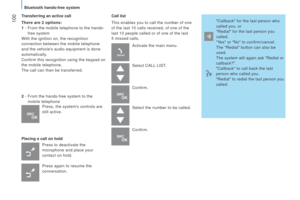 102
102 103
103 104
104 105
105 106
106 107
107 108
108 109
109 110
110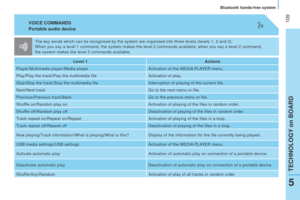 111
111 112
112 113
113 114
114 115
115 116
116 117
117 118
118 119
119 120
120 121
121 122
122 123
123 124
124 125
125 126
126 127
127 128
128 129
129 130
130 131
131 132
132 133
133 134
134 135
135 136
136 137
137 138
138 139
139 140
140 141
141 142
142 143
143 144
144 145
145 146
146 147
147 148
148 149
149 150
150 151
151 152
152 153
153 154
154 155
155 156
156 157
157 158
158 159
159 160
160 161
161 162
162 163
163 164
164 165
165 166
166 167
167 168
168 169
169 170
170 171
171 172
172 173
173 174
174 175
175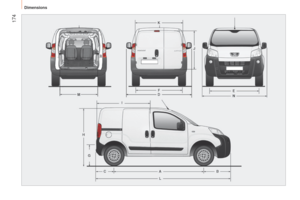 176
176 177
177 178
178 179
179 180
180 181
181 182
182 183
183 184
184 185
185 186
186 187
187 188
188 189
189 190
190 191
191






